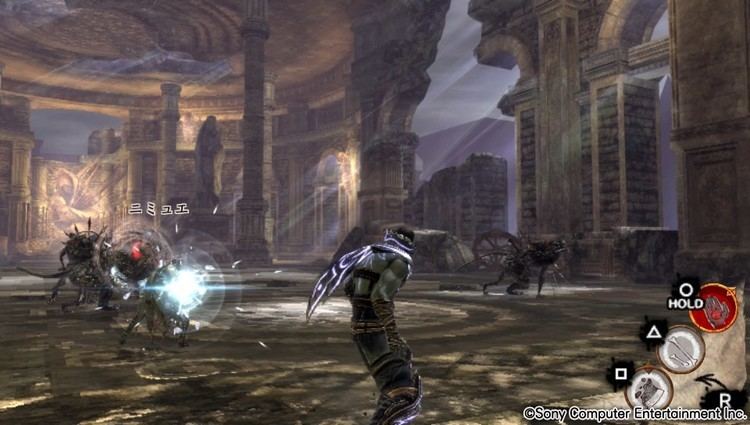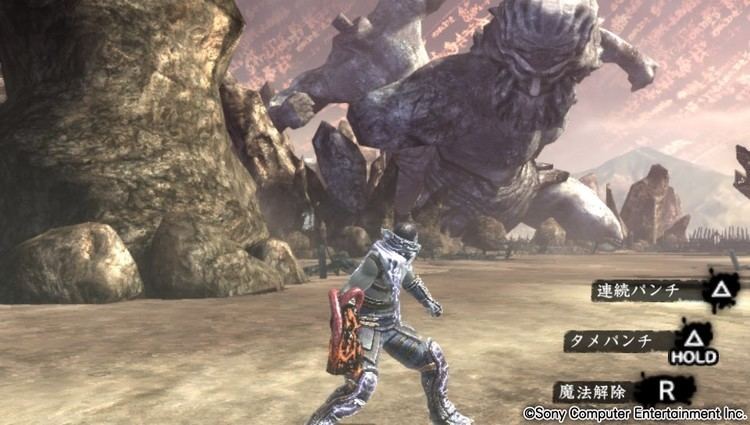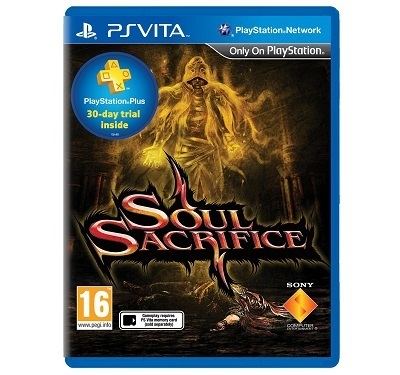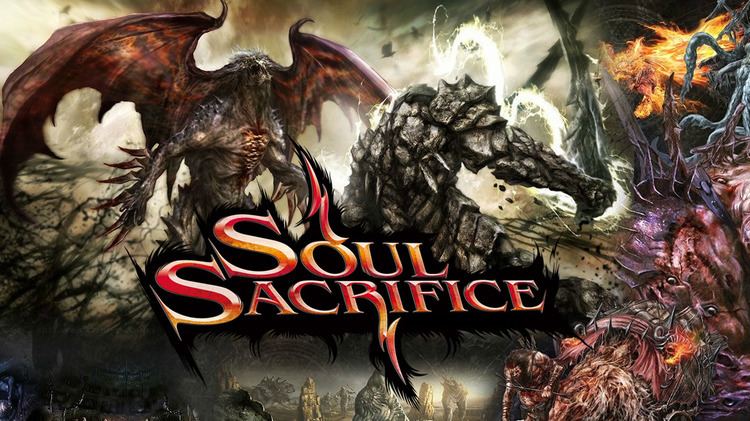7.6 /10 1 Votes7.6
7.7/10 IGN Director(s) Teruhiro Shimokawa Genre Action-adventure game | 77% Metacritic 7.5/10 GameSpot Initial release date 30 April 2013 | |||||||||||||||||||||||||||||||||
 | ||||||||||||||||||||||||||||||||||
Producer(s) Kentarou MotomuraTeruyuki Toriyama Composer(s) Yasunori MitsudaWataru Hokoyama Mode(s) Single-player, multiplayer Developers Comcept, Marvelous, SIE Japan Studio Similar Sony Interactive Entertainment games, Action-adventure games | ||||||||||||||||||||||||||||||||||
Soul Sacrifice (ソウル・サクリファイス, Souru Sakurifaisu) is an action-adventure video game developed by Marvelous AQL and Japan Studio and published by Sony Computer Entertainment for PlayStation Vita. It was released in Japan on March 7, 2013, in North America on April 30, 2013, and in Europe on May 1, 2013.
Contents

The core mechanic of the game is the ability to sacrifice parts of the character's body or items to create devastating attacks. These sacrifices will be permanently marked on the player character's body, meaning that they are not an infinite resource that can be tapped into. The concept was created by Keiji Inafune.

An expanded version of the game, titled Soul Sacrifice Delta, was announced during TGS 2013, and was released in Japan on March 6, 2014, in North America on May 13, 2014, and in Europe on May 14, 2014, for the PlayStation Vita.

Plot

The main protagonist of Soul Sacrifice is one of the innocent bystanders that has been enslaved by a powerful and cruel sorcerer known as Magusar, who absorbs human sacrifices to remain immortal. Just before the protagonist is going to be sacrificed, a talking book appears before them. The book, named Librom, is a collection of stories that describe past fights between monsters and the powerful sorcerer. The player character is able to enter the book's world and experience the fights in events known as Phantom Quests, thereby gaining the experience and power needed to defeat Magusar.
The game has two endings depending on whether the player saves or sacrifices Magusar after his defeat. There is also a third ending that occurs if the player defeats Magusar before completing all of the main stories in Librom.
Gameplay
Soul Sacrifice is played in the third-person perspective. The player character is a sorcerer who relives another sorcerer's memories through a journal. The character can be customized in various options and can change throughout the game. The abilities ("sacrifices") are part of this customization, which allows the game to have roles such as tank, ranged caster or melee DPS. The game features four-player cooperative play and the ability to sacrifice party members to destroy powerful foes. The slain party members are not given the usual recognition in a game, such as experience points. However, the player does gain bonus points for being sacrificed. Four-player cooperative play is only available on some quests, such as Inside Avalon (a portion of the journal).
Combat
Central to the combat system is the saving and sacrificing mechanics. When an enemy or ally is defeated, they collapse to the ground and you are given the choice to either save or sacrifice them. Saving an enemy restores a small portion of health, while saving an ally consumes 1/2 your current health but restores that ally back to the fight. Players can also choose to sacrifice their allies to create a powerful map wide damaging spell. However, sacrificed players can no longer be healed and enter a spectator type mode in which they can continue to watch the fight. Sacrificed players have the benefit of being able to see numerical damage figures and exact health bars. They are also able to tap the screen to either boost allies or weaken enemies. Sacrificed allies do not gain any additional experience from the fight, but do still gain mission rewards if the stage is cleared. Sacrificing an enemy restores charges to items known as offerings which are required for the casting of magic. Each offering has a set number of times it can be used without being recharged before it breaks. If all the charges on the offering are used, the offering will break and cannot be recharged in the normal fashion. Instead, broken offerings need to be repaired using Lacrima (Librom's tears), a type of in game currency which is awarded for clearing stages.
Players are also given the option to sacrifice a part of their own body when they receive enough damage. When a player chooses to sacrifice a part of themselves, they cast a powerful spell, known as black rites, which differs depending on what part of the body is being sacrificed but also suffer a semi-permanent status effect. For example, the player's defense is reduced by 50% for sacrificing their skin or their field of vision is reduced for sacrificing their eyes. This status effect remains active until players use Librom's Lacrima from the game menu to restore their broken bodies similar to restoring broken offerings.
Reward system
Soul Sacrifice uses a point/objective system to calculate mission rewards. Rewards come in the form of spell offerings. Each mission has at least three different offerings you can obtain from that mission, more if that mission has bosses in it. In addition to mission specific bonuses, performing certain tasks such as sacrificing an ally, being sacrificed, or using a forbidden spell will also grant players an additional offering as a reward. The normal mission rewards are broken into four ranks. Ranks are obtained by completing certain tasks for points. For example, successfully performing a counterattack is worth 10 points, while completing a stage without getting hit is worth 100 points. Because of this point system, being sacrificed by an ally after dying can be beneficial. Being sacrificed rewards both the player being sacrificed and the one performing the sacrifice with 100 points . The exact amount of points for each rank changes depending on the mission. If the mission contains a boss, players can receive additional spells by "breaking" weak points on the boss. Each boss has a single break reward and that reward can be earned as many times as the boss has weak points (usually 2 or 3).
Multiplayer
Soul Sacrifice uses the PlayStation Network to allow up to three additional players to join you in "Avalon Quests" which are side missions to the main story line. The online component requires an online pass which is bundled with new copies of the program as well as obtainable through the PlayStation Store. Any progress made through the multiplayer is also added to your single player campaign. The game also allows for Ad-Hoc connections for local players to enjoy the game without using the PlayStation Network.
Near support
The PlayStation Vita program Near is used in the game's multiplayer section for players to share spells with other players in their immediate area. Any spell "gifted" through the Near application is not removed from the player's inventory. Instead it makes a copy and allows other nearby players to receive the gift for free. However, some spells, such as those acquired through pre-order bonuses or importing demo save data, cannot be gifted. Use of this function does require the online pass.
Release
Soul Sacrifice was released worldwide throughout 2013 on March 7 in Japan, April 30 in North America and May 1 in Europe. In Japan, it was launched with a PlayStation Vita bundle that includes a cosmic-red-colored PS Vita system with a custom design on the back, red earphones, a 4GB memory card, a pouch, a strap, and a cloth. On April 12, 2013, Sony announced that the game demo would be released on April 17, 2013.
Reception
Soul Sacrifice received generally positive reviews from critics, holding a Metacritic score of 77. Most reviewers concur that the game has addictive gameplay and a very detailed combat system but lament the poorly-programmed AI allies and repetitive level designs and enemies. IGN gave the game a 7.7 out of 10, Destructoid an 8 out of 10, and Forbes an 8.5 out of 10. Japanese reviewers gave the game favourable scores; most notably, Famitsu gave Soul Sacrifice a review score of 37/40.
Soul Sacrifice was a breakout hit in Japan, and one of the most successful debuts for a new intellectual property from Japan Studio on a handheld system. The game sold 92,396 copies of the standard physical retail version and 22,050 copies of the special Double Pack within the first week of release in Japan. Sales reached almost 200,000 copies in the second week. Soul Sacrifice was the fifth most purchased digital Vita game on the Japanese PlayStation Network in 2013.
The enhanced Soul Sacrifice Delta was also given a Famitsu review score of 37/40.
Sequel
In a conversation with IGN, Keiji Inafune has expressed his interest in making a sequel to Soul Sacrifice; "...To drive Vita sales even more, I have an idea for a Soul Sacrifice sequel. I’m actually approaching Sony Computer Entertainment regarding this project." He later went on to say; "Let's say the talks are ongoing and I'd love to make it happen." At SCEJA's 99 event, an expansion of the original game titled Soul Sacrifice Delta was announced. The game includes new bosses, a third faction called 'Grimm', co-op attacks and more. The game was released in Asian markets on March 6, 2014, in North America on May 13, 2014 and in Europe on May 14, 2014.
Soul Sacrifice Delta sold 48,786 physical retail copies during its first week of release in Japan, topping the software sales charts for that particular week.
